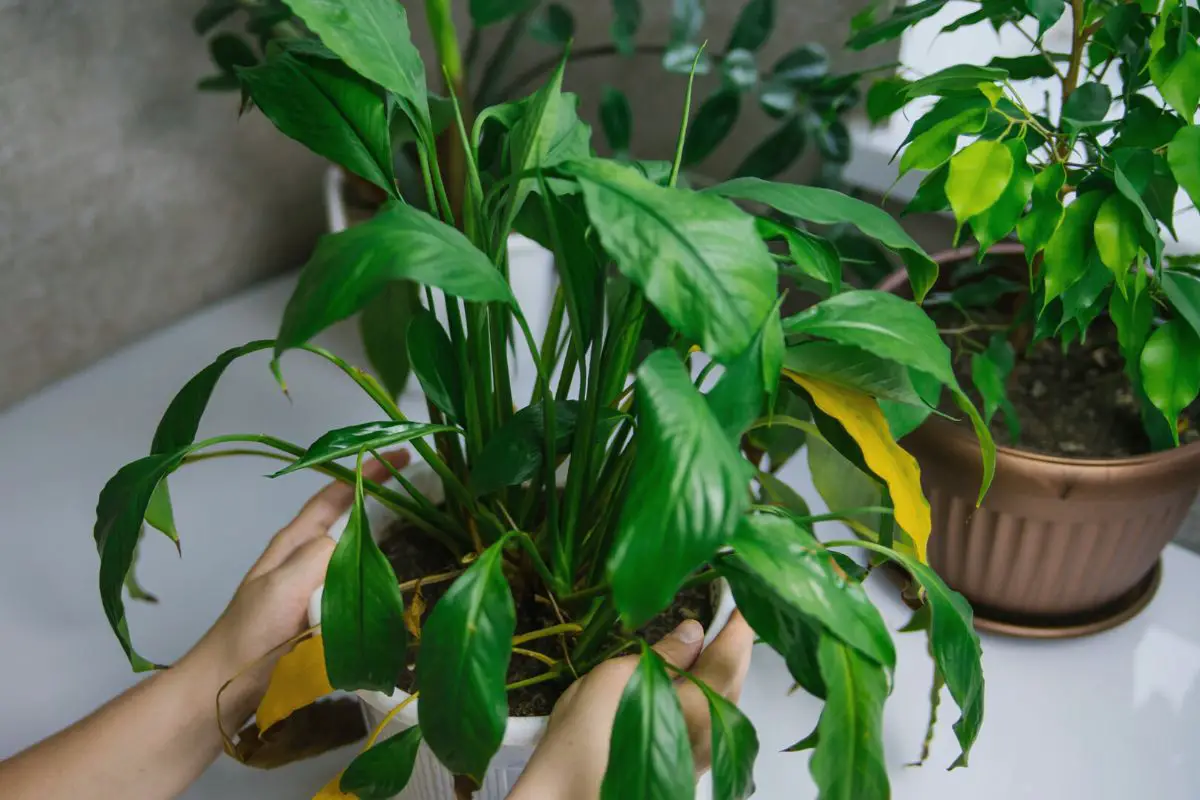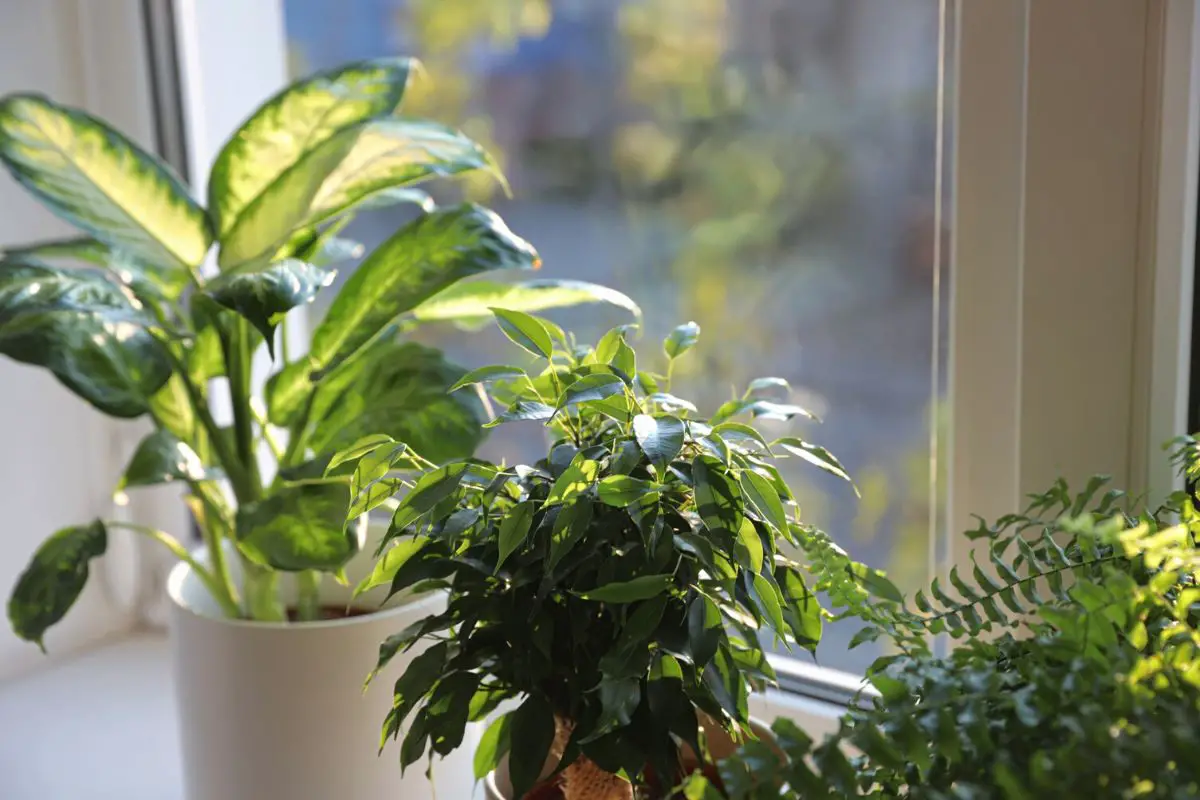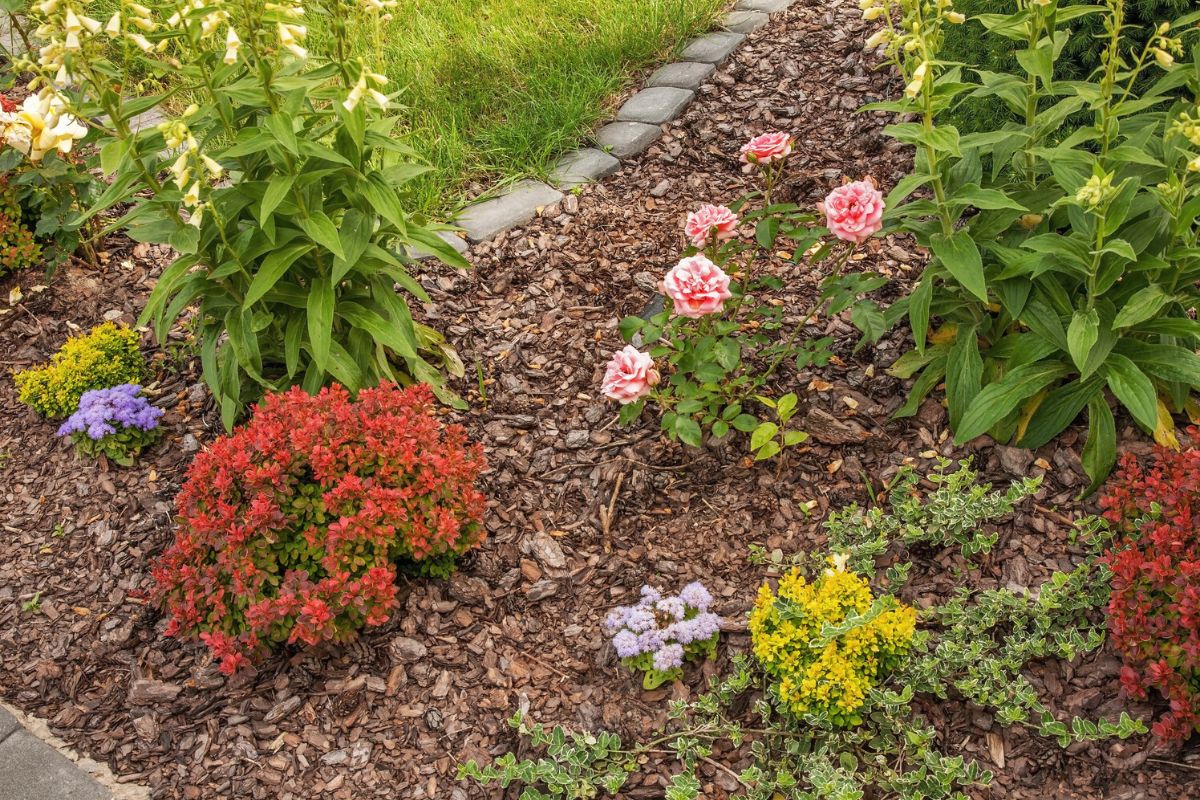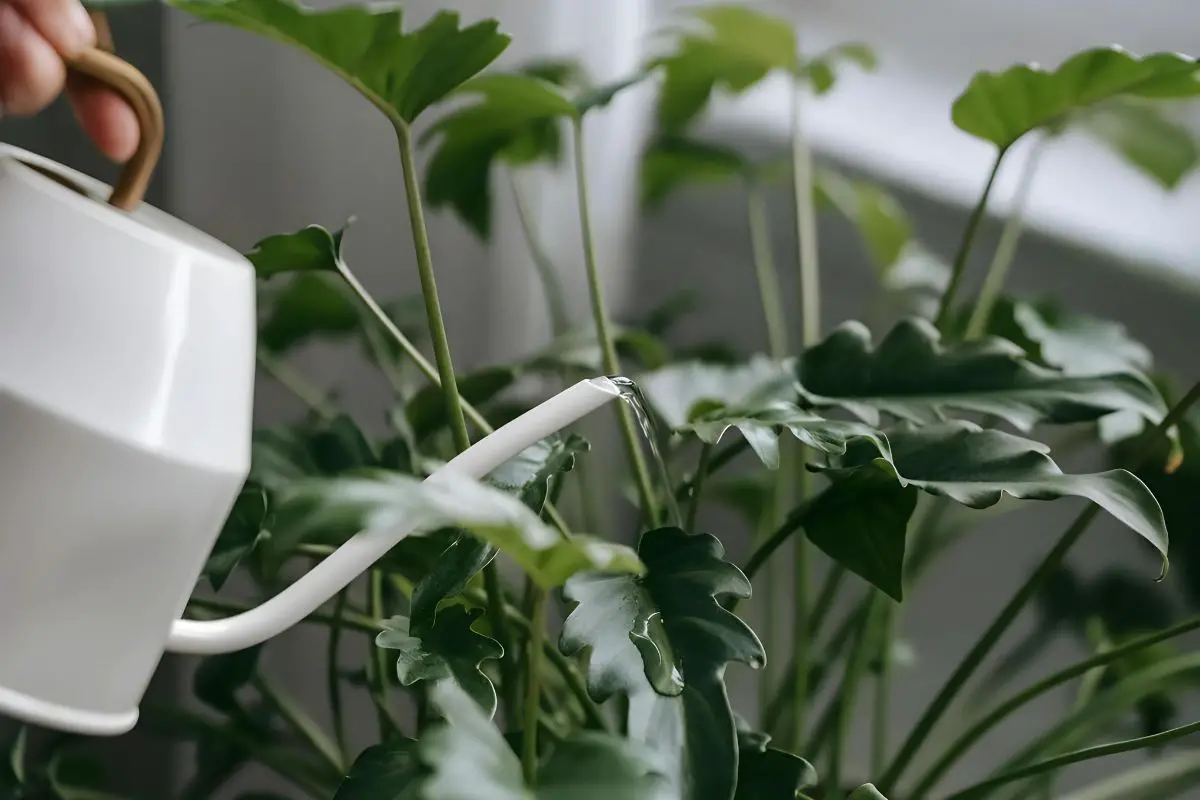Houseplants need more careful watering because they don’t receive adequate moisture from rainfall. They also have limited soil space that may hold or drain too much water. These make their water requirement challenging to get correctly.
Overwatering and underwatering are common problems with houseplant care. These issues have a few similar symptoms, such as wilting and yellowing or browning leaves. It’s crucial to identify the issue correctly to apply the appropriate solutions.
This article will discuss everything you need to know about the water needs of houseplants. I will also share how to fix watering issues and prevent them from reoccurring in the future.

A Quick Reference
The tables below provide shared and distinct signs of overwatering and underwatering signs in plants:
Shared Signs (and Ways to Distinguish these)
| Shared Signs | Overwatering | Underwatering |
| Wilting | The soil remains wet a few days after watering, but the plant is still wilting. | The plant perks up after watering. |
| Yellow leaves | The yellow sections feel mushy and the leaves are dropping. | The yellowing starts from the edges and the tips appear brown and dry. |
| Brown leaves | The brown spots are wet or mushy. | The browning starts from the leaf edges and feels crisp. |
| Wrinkled leaves (succulents) | There’s a foul odor coming from the roots, indicating root rot. The leaves have blister marks and are falling. | The succulent leaves regain their plump appearance after watering. |
Distinct Signs
| Overwatering | Underwatering |
| Foul odor from soil | Dry, crispy leaves |
| Mildew, mold, or fungal growth | Slow, stunted growth |
| Soft, mushy stem | Brittle, crisp stem |
| Blisters on leaves | Soil pulling away from pot sides |
| Pests |
Plant Water Needs: An Overview
Water is an indispensable requirement for plant health and growth for the following reasons:
- Soil microbes and minerals need water to undergo biological and chemical reactions to convert minerals into nutrients accessible to plant roots.
- Water binds to nutrients and delivers them to the whole plant.
- It aids in maintaining turgidity in plant cells, keeping them from wilting.
- It contributes to a plant’s transpiration rate, stomata opening and closing, and the consequent gas exchange between carbon dioxide and oxygen.
These functions apply to all plants. However, various plant species have different watering requirements.
- Drought-tolerant plants, such as cacti and succulents, can get by with less frequent watering than others because of their water-retentive adaptations. These plants thrive in arid regions and have modified leaves, stems, or roots that absorb extra water during rare rainy days and store it for extended periods of drought.
- Tropical plants receive plenty of water from frequent rainfalls, so they don’t usually develop deep roots. Epiphytic plants develop aerial roots to absorb moisture from the air, which has high humidity all year round. Purely terrestrial tropical plants, however, need consistently moist soil.
- Plants with modified roots like bulbs, rhizomes, tubers, or deep taproots can survive periods of drought better than shallow, fibrous-rooted plants.
Factors Influencing Soil Moisture Adequacy for Houseplants
In your home environment, multiple factors can influence how to adjust your watering routine and how well the houseplants can thrive.
These factors include the following:
- Plant Species: As discussed, different plants have different water requirements (i.e., amount, frequency).
- Soil type: Loose, sandy soil drains water freely, whereas clayey soil holds moisture for a long time. Finding the right balance between moisture retention and drainage is crucial for plant health.
- Pot size: Too-large pots with poor soil drainage can hold too much moisture, putting your plant at risk of overwatering and root rot.
- Environment: The temperature, humidity, and light intensity in your home can also influence how quickly the water escapes from the soil via evaporation or plant transpiration.
Considering the facts discussed above, there’s no hard-and-fast rule about watering houseplants. It helps to know how to identify the signs of watering errors to address the problem promptly and correctly.

Shared Signs of Overwatering and Underwatering
When a houseplant starts showing signs of stress, inexperienced gardeners may assume it needs a drink. Before deciding on the solution, it’s worth noting that overwatering and underwatering share common signs.
These signs include the following:
Wilting or Drooping
Water keeps plant cells turgid, allowing the stems to remain plump and stable while the leaves and flowers appear perky. Without enough water in the cells, the plant will naturally droop or appear limp.
Underwatering leads to dehydration, so it’s easy to think that your plant is wilting due to lack of water. However, chronic overwatering can cause root rot, preventing proper water uptake. Although the roots are sitting in wet soil, the shoots aboveground are dehydrated.
You can tell apart the root cause by checking the soil. If it appears and feels wet about 3 days after watering but the plant is still wilting, it means you’re dealing with overwatering. On the other hand, if your plant perks up after watering, it means it was underwatered.
Brown Leaves
Plant leaves turn brown to indicate stress due to sunburn or watering issues. You can tell your plant is underwatered if the leaves turn brown from the tips and the discolored parts feel dry and crisp.
Conversely, overwatered plants will have brown, irregularly located, water-soaked spots on the leaves.
Yellow Leaves
Yellow leaves can also indicate water issues or lack of sunlight. Yellowing due to overwatering is often accompanied by a mushy texture and leaf drop. On the other hand, dehydrated leaves will turn yellow from the edges with dry, crisp, and brown tips.
Wrinkled Leaves
Succulent leaves won’t turn yellow or brown right away when dehydrated. Instead, they will first appear wrinkly as the cells shrink due to lack of water. Watering a thirsty plant will help the leaves regain their plump appearance.
Even overwatered succulents will also have wrinkled leaves if the root system has been severely damaged by rot. Watering your plant in this case won’t help restore the leaf shape and can worsen the condition.
You can confirm that the symptom is due to overwatering if it comes with a foul odor from the soil and falling leaves. The leaves will also have blister marks as an earlier sign of overwatering.

Signs of Overwatering
In addition to the signs above, here are distinct signs that your plant is overwatered:
Foul Odor from the Soil
Too much water in the soil can block air spaces and suffocate the roots, preventing them from taking up oxygen. The roots will become weaker and become more susceptible to damage caused by soil pathogens.
The constant moisture can also encourage rapid fungal growth, leading to root rot. As the roots decay from fungal activities, they give off a foul smell that can seep out of the soil surface. This is a definitive sign that the roots are rotting.
Mildew, Mold, or Fungal Growth
Fungi can also grow aboveground if a plant is overwatered. If the foliage is constantly wet, fungi populations can rapidly increase, often appearing as a white or colored layer over the leaf or soil surface.
Mold and mildew are some of the most common fungi species growing on plant leaves. In large enough populations, they can block the leaf surface and inhibit photosynthesis and transpiration.
Mushrooms, which are reproductive structures of fungi, may also grow over the wet soil surface.
Soft, Mushy Stem
If root rot remains undetected and untreated, the decay will climb up the plant crown and stem, causing them to become soft and mushy. The plant will then droop as the base of the stem can no longer support its weight.
Blisters on Leaves
Succulents and cacti have naturally plump leaves or stems that store water, giving them drought tolerance. Too much water in the soil accompanied by high temperature and light intensity will encourage a higher transpiration rate and excessive water uptake.
With frequent watering, the cells will eventually burst, leaving wounds or blisters on the leaf or stem surface.
Pests
Many plant pests like aphids, mealybugs, and spider mites thrive in humid areas and feed on the sap of leaves and stems. They’re attracted to overwatered plants, especially if the foliage remains wet throughout the day. The plump leaves will also be an excellent source of sap.
Pests like fungus gnats prefer to lay eggs in constantly moist soil so the larvae can feed on fungi and plant roots as they hatch.
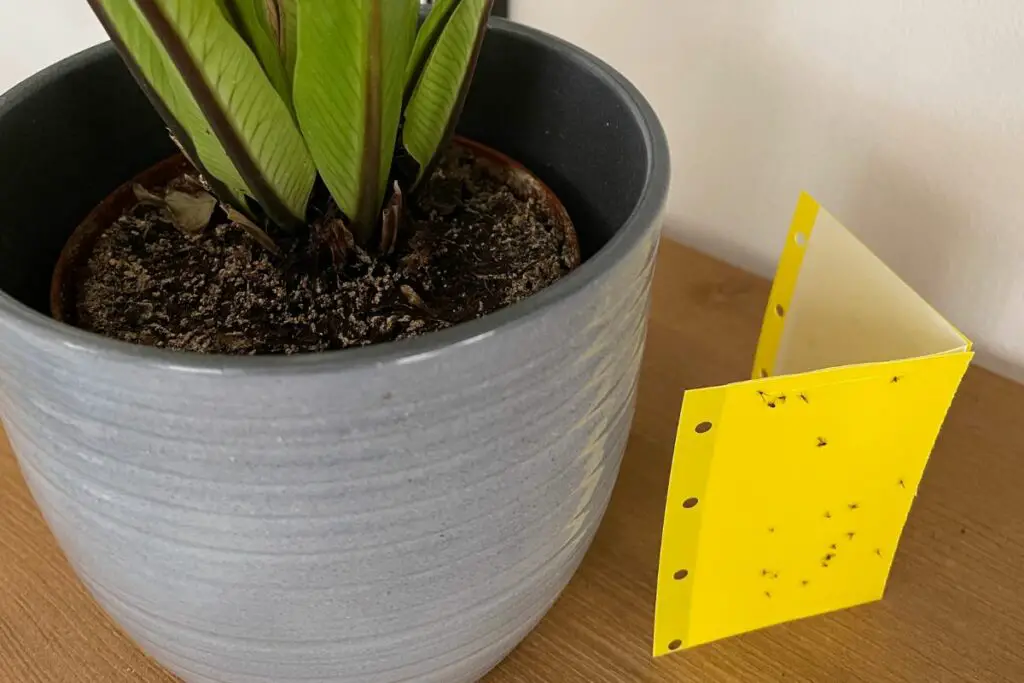
Signs of Underwatering
To confirm that your plant is underwatered, you can refer to the signs below:
Dry, Crispy Leaves
Sunburn may also lead to dry, crispy leaves. However, the damage caused by sunburn will occur on the side of the plant constantly exposed to sunlight, and it can appear anywhere on the leaf surface. This occurs when you don’t rotate your houseplant for a long time.
Conversely, underwatered plants will dry out starting from the edges. The leaf tips will first turn yellow, then brown, and become dry and crispy.
Slow, Stunted Growth
Many houseplants can endure brief periods of drought. Moisture-loving plants exhibit stress symptoms sooner than drought-tolerant plants but quickly bounce back once rehydrated. However, chronic underwatering will cause them to grow slowly.
Flowering or fruit plants will be unproductive even during their growing season if they don’t receive enough water. Seedlings will also take longer to grow or establish roots if they don’t have constantly moist soil.
Brittle, Crisp Stem
Mature plants can retain moisture in their stem and stay alive even when most of the foliage dries out from dehydration. If the inside of the stem still appears green, you can still revive your plant by rehydrating it.
Meanwhile, young plants with small stems will succumb to chronic underwatering more quickly. The dried-out branches and stems will feel brittle and crisp. At this point, it will be impossible to revive your plant.
Soil Pulling Away From Pot Sides
Soil microbes naturally break down dead plant matter and release fatty acids or hydrophobic compounds, which build up in the soil over time.
If you frequently allow your soil to become bone-dry between watering, these compounds will bind around soil particles like wax, making them hydrophobic.
Dry soil will lose its volume and start pulling away from the inner sides of the pot. The water will then slide through the gaps and exit through the drainage holes without penetrating through the root zone.
Even if you water it, the waxy covering of soil particles will repel the water and your plant will remain thirsty.
Preventative Measures
The symptoms listed above can easily be avoided by following the tips below:
Understand Your Plant’s Specific Water Needs
For years, I was able to avoid watering issues by keeping a few basic guidelines in mind.
- Water moisture-loving plants as soon as the top 1-2 inches (2.5-5 cm) of the soil is dry.
- Water drought-tolerant plants when the upper 2-3 inches (5-7.6 cm) or half of the potting mix is dry.
- Check hanging baskets regularly and water as soon as the top inch (2.5 cm) is dry. This sometimes requires watering twice a day, especially during hot and bright days and if your home has low humidity.
Check Soil Moisture Before Watering
To check the moisture, you can dig your fingers into the soil. One knuckle is roughly an inch (2.5 cm) and two knuckles are 2 inches (5 cm).
You can also use a wooden chopstick with markings to avoid damaging the roots or if you have deep pots or moss poles.
Here’s a practical guideline I follow from years of caring for houseplants:
- For houseplants growing in regular pots, check the soil 5-7 days after the previous watering session.
- Plants in hanging baskets need daily checks, sometimes even twice a day.
- Use a chopstick to check the moisture for plants growing on moss poles, such as Monstera spp. Poke the chopstick through the wire mesh to check if the moss is dry about ½-1 inch (1.3-2.5 cm) through. The moss typically requires a weekly thorough watering followed by misting every 2-3 days to prevent it from drying out.
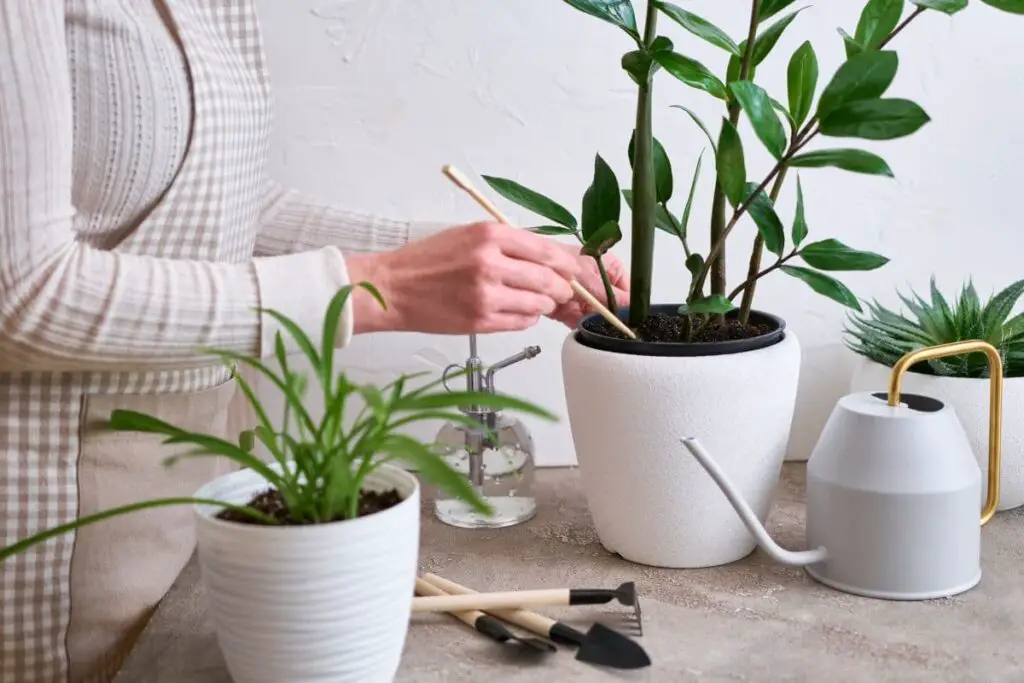
Use Pots and Soil With Proper Drainage
Indoor plant pots should have drainage holes to keep your houseplant from sitting in wet soil for a long time. Breathable pots like unglazed terracotta also help wick away excess moisture from the soil.
The soil or potting mix should also have proper drainage, which you can improve by adding perlite. Other alternatives include horticultural sand, pumice, and coconut coir.
If you need to improve moisture retention for tropical houseplants, you can use coco peat, compost, or vermiculite. These materials can hold moisture while being porous, allowing adequate air circulation around the roots.
Adjust the Watering Schedule Based on the Seasons
Seasonal changes affect the water requirements of houseplants in two ways:
- Houseplants need more water during their active growing season, which is typically in spring and summer. Tropical houseplants don’t go dormant outside their growing season. However, they grow slowly and require less water during the cold seasons.
- Indoor conditions (light, temperature, humidity) are affected by changing seasons. You can keep these conditions consistent all year round if you use grow lights, air conditioners, humidifiers, and dehumidifiers. However, it can be costly and unnecessary since houseplants need environmental cues like lower temperatures and light levels to trigger flower, leaf, or fruit bud formation for the following spring.
That said, it’s important to check the soil moisture regularly and adjust your watering schedule to prevent watering errors.
Solutions for Watering Issues
If your plant still shows stress from watering issues despite your best efforts, diagnose the root cause of your plant’s stress using the guidelines above.
You can then apply the following solutions accordingly:
How To Fix Overwatered Plants
You can fix mildly overwatered plants by reducing the watering frequency. Allow the soil to dry out enough before watering your plant again.
You may need to repot the plant if you see the following issues:
- The plant is showing signs of root rot.
- The potting mix has become compacted.
- The potting mix has too many moisture-retaining materials like vermiculite, peat moss, or compost.
In this case, you can follow the steps below for safe repotting:
- Water the plant 1-2 days before repotting to make the soil easier to work with.
- Loosen the soil around the inner sides of the pot using a spatula or flat knife. Carefully slide the plant out.
- Gently rub the soil off the roots with your fingers. Rinse off the remaining soil with tepid, gentle running water.
- Inspect the roots for signs of rot or damage. Healthy roots should be light brown or white and plump. Rotten or damaged roots will appear shriveled and dark brown or black.
- Prune the damaged roots using sterile shears. Limit pruning to only a third of the root system.
- Prepare a pot about 1-2 inches (2.5-5 cm) wider and 2-3 inches (5-7.6 cm) deeper than the rootball after pruning. Ensure it has drainage holes.
- Prepare a fresh potting mix with better drainage. Materials like perlite and pumice are excellent for improving soil drainage. Moisten the potting mix a day before repotting.
- Place your plant in the new pot and soil.
- Water your plant deeply. For succulents, wait until the upper half of the potting mix is completely dry before watering again.
How To Fix Underwatered Plants
There are several ways to fix underwatered plants, depending on the severity of the issue:
- Water your plant deeply. Mildly underwatered plants should perk up within a few days. Plants with discolored leaves need a few more watering sessions to revive.
- Keep an eye on the soil moisture and increase the watering frequency if it dries out too quickly.
- Spread a thin layer of compost over the soil surface, keeping it about ½ inch (1.3 cm) below the rim of the pot to avoid spilling. It can work as mulch to help retain moisture.
You can gradually rehydrate hydrophobic soil by soaking the entire pot in water for 1-2 hours. Once the soil is dry enough (depending on plant type), water the plant normally and observe if the water is penetrating the soil properly.
If it is, then you can keep the plant in the same pot and water your plant as needed. Otherwise, it’s best to repot the plant following the same steps discussed above.
When repotting, I also recommend purchasing or using a high-quality potting mix with adequate drainage and moisture retention capacity suitable for your plant type. For instance, use a standard cacti or succulent mix for drought-tolerant plants.
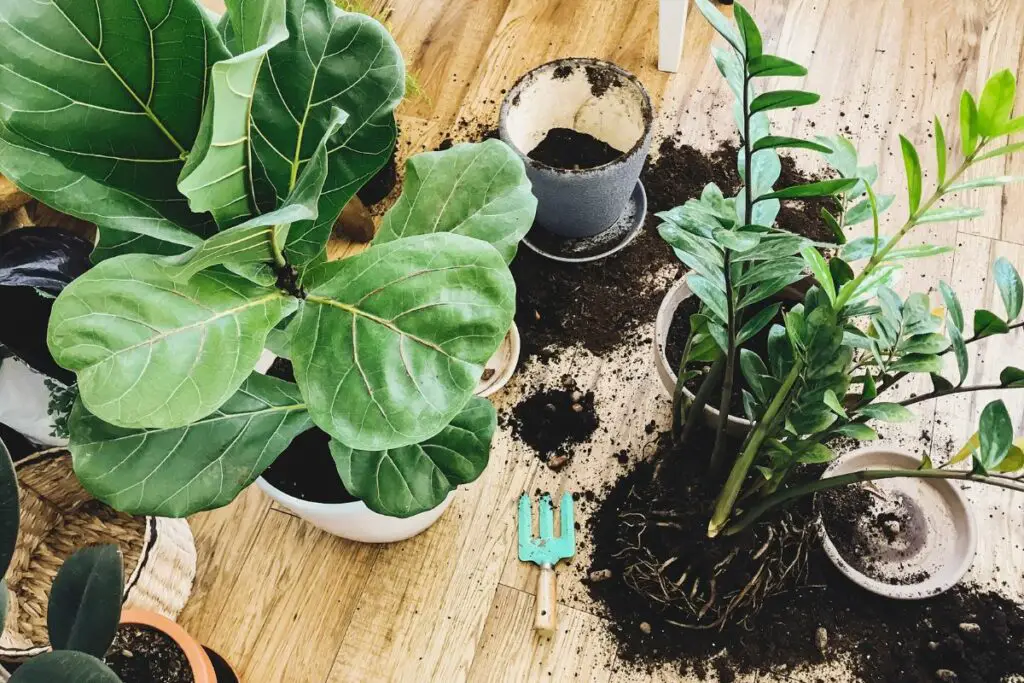
Techniques for Proper Watering
Although overwatering and underwatering are common issues, they can easily be avoided with proper watering techniques.
Here are some tips you may find useful:
- Water your houseplant gradually using a watering can with a narrow spout to ensure proper water penetration into the soil.
- Avoid wetting the foliage to prevent microbial growth that can lead to diseases. It can also discourage common plant pests from attacking your plant.
- Water established houseplants deeply. This will prevent rapid moisture loss, encourage deeper root growth, and reduce the risk of dehydration.
- Create a watering reminder using a mobile alarm or calendar that estimates when to check the soil or water your plant. You still have to manually check the soil moisture after you see the reminder to avoid over- or underwatering your plants.
- Use self-watering pots for plants that like consistently moist soil, such as ferns. Note that you still need to water your plant from the top once a month during fertilization season to leach excess fertilizer salts from the soil.
- Use moisture meters for more accurate soil moisture readings. Some products come with plant-specific guides to watering.
- Place your pot on a pebbled tray with water to boost the local humidity around your plant and prevent rapid moisture loss from the soil.
- Use tepid water with temperatures around 62-72 °F (17-22 °C) to prevent stress from cold shock or burns. Soil microbes are also active at these temperatures, allowing proper nutrient breakdown and absorption by the plant’s roots.
Final Thoughts
Overwatering and underwatering share some common signs, such as yellow or brown leaves, wilting, or drooping. It’s important to inspect your houseplant and the potting soil thoroughly so you can diagnose and treat your plant correctly.
You can prevent watering problems by understanding your plant’s watering needs, using the correct soil mix, and using a watering schedule. It also helps to keep an eye on your plant regularly for early detection and treatment of signs of stress.
If you have questions or want to share valuable insights about the watering needs of houseplants, don’t hesitate to reach out!

